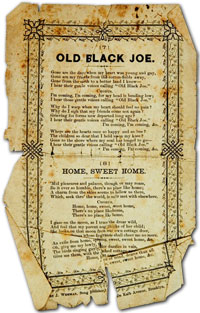
Old Black Joe
Stephen Collins Foster was born on July 4, 1826 in Pittsburgh, Pennsylvania, and was the second youngest of eleven children. He worked as a bookkeeper with
his brother in Cincinnati for three years while spending much of his time perfecting his passion, composing music. At 18 years old, Foster published
his first song, Open Thy Lattice, Love, and went on to write at least 200 songs including Oh! Susanna, Camptown Races, My Old Kentucky Home,
and Beautiful Dreamer.
Foster's tender song entitled Old Black Joe reflects upon a time of innocence etched in the composer's memory. The lyrics tell of his friendship
with local enslaved farm workers and the grief he experienced after their passing. The figure Joe, portrayed as an elderly slave, embodies Foster's
sentiments about this experience, and his lyrics are considered to be the first to elevate the dignity of the black slave. Foster's repertoire became so
popular that his songs were often published as song sheets (words only) because it was understood that the public already knew the melody. The popularity
of the song Old Black Joe was later revitalized by Al Jolson's performance in the 1939 film Swanee River, a fictionalized musical biography
of Foster's life. The song also inspired Horace Pippin's painting Old Black Joe (1943) now in the Smithsonian American Art Museum, as well as
numerous ephemeral items on the same subject.
Due to lack of efficient copyright laws a number of Foster's songs were stolen and he died poor at the age of 38. In 1951, the United States Congress
paid tribute to Foster by designating his songs Old Black Joe, My Old Kentucky Home, and Old Folks at Home, "national expressions of democracy" and
declaring the composer Stephen Collins Foster, "Father of American folk music."
Home Sweet Home
Home Sweet Home was written by John Howard Payne. Where exactly Payne was born is a matter of controversy; some say he was born in Boston
while others insist he was born in New York on June 9, 1791. Nevertheless, Payne spent most of his childhood on Long Island where his father, William
Payne, became the headmaster of the prestigious Clinton Academy located in East Hampton. Around the age of 14, Payne went to work as a clerk, although he
yearned for the theatre. Thus, Payne would work during the day and go to his beloved theatre at night. Payne began publishing the Thespian
Mirror, a weekly journal of theatre reviews after which he starred in his first acting role in a production of Douglas, and then toured the United
States in multiple productions. Payne then decided to test his craft in London, where he became one of the first important American actors on the British
stage. When his acting career began to dwindle, he started to write plays to earn extra money. He met and became friends with Washington Irving, with
whom he collaborated on a number of works, among them, Charles the Second and Richelieu: A Domestic Tragedy. Although the work was written
jointly, only Payne was credited for its authorship. While in Paris with a production of Clari, or the Maid of Milan (1823), he met
Sir Henry Bishop who convinced Payne to rewrite Clari into an operetta. For this piece he wrote his famous Home Sweet Home. Home Sweet
Home became so popular that it was printed separately from the rest of Clari's score. The inspiration for the song is thought to be the
old house in East Hampton, Long Island where Payne grew up. Even after his death in 1852, Payne's Home Sweet Home was popular with both the
Civil War Unionist and the Confederate troops because both sides longed for their homes and families. It was later performed for President Abraham
Lincoln at the White House. At the end of Payne's life, he abandoned both acting and writing and became a consulate for the United States government.
Bibliography: Old Black JoeThe Lester S. Levy Collection of Sheet Music, available at http://levysheetmusic.mse.jhu.edu [accessed 12 October 2005];
The Ephemera Society of America, available at http://www.ephemerasociety.org [accessed 12 October 2005]; The Center for Popular Music,
Middle Tennessee State University, available at http://popmusic.mtsu.edu/ [accessed 12 October 2005]; American Memory, African-American Sheet Music,
1850-1920, available at http://memory.loc.gov, [accessed 12 October 2005]; Center for American Music, available at
http://www.pitt.edu/~amerimus/ofah.htm[accessed 12 October 2005]; R. Jackson, Popular Songs: nineteenth-century America: complete original sheet music
for 64 songs, New York, 1976; M. Klamkin, Old Sheet Music: a pictorial history, New York, Inc, 1975; J. Olney. I Aint Gonna Be No Topsy,
Because Paris Is My Old Kentucky Home, The Southern Review, v.37, 2001; Horace Pippin, 1888-1946, Old Black Joe, 1943 Smithsonian American Art
Museum, available at http://americanart.si.edu/art_info02.html [accessed12 October 2005]; Music related postcards, available at
http://www.the-forum.com/EPHEMERA/musicpc.htm [accessed 12 October 2005].
Bibliography: Home Sweet Home
P. Goodman, Newsday, Payne's Sweet Song, an Actor, Writer, Producer and Ambassador best known for "Home Sweet Home",
available at http://www.newsday.com/[accessed 11 October 2005]; Song Writers Hall of Fame, John Howard Payne, available at
http://www.songwritershalloffame.org/ [accessed 11 October, 2005]; E. Elliot, Dictionary of Literary Biography Volume 37: American Writers of
the Early Republic, John Howard Payne, Princeton, 1985; G. Levis, Isle of Shells: Long Island, New York, 1965.
|

